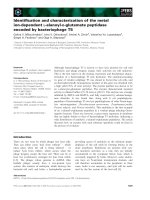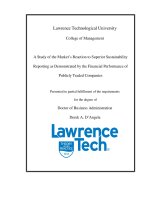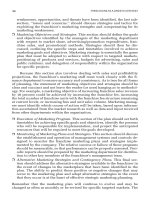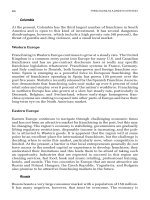The Shark and the Goldfish Positive Ways to Thrive During Waves of Change by Jon Gordon_10 pdf
Bạn đang xem bản rút gọn của tài liệu. Xem và tải ngay bản đầy đủ của tài liệu tại đây (841.61 KB, 25 trang )
Prerequisite Tree
203
obstacles. Now it is time to determine the order in which the
intermediate objectives must be accomplished. What should be
worked on first, second, and third? Is there an inherent order
among the intermediate objectives? Must any of the intermediate
objectives come before the others? Can any of the intermediate
objectives be accomplished in parallel? You will answer these
questions by establishing more precisely any necessary condition
relationships that exist among the intermediate objectives.
a.
Identify two inter mediate objectives that appear to have a
time dependency between them.
Your intuition is telling you
that one needs to be implemented before or after the other
(Figure 10.3).
b.
Diagram the r elationship as a necessary condition r ela-
tionship.
Between the two, the arrow points from the earlier
intermediate objective to the later one. The obstacle that the
intermediate objective overcomes is verbalized on the arrow itself.
c.
Scrutinize the r elationship you’ve just diagrammed using
necessary condition thinking
(see Chapter 5), adding inter-
mediate objectives and obstacles if necessary. In this step, you
are checking the assumptions behind the need to accomplish
intermediate objective io-1 before io-2.
i. The first element you are going to check is the obstacle ob-1
(see Figure 10.4). Is this entity preventing the accomplishment
of intermediate objective io-2? If so, when you read the nec-
essary condition relationship, it will make sense and ring true.
Check that the obstacle is an obstacle to the intermediate
objective it now points to, using the causality existence reser-
vation:
•We cannot accomplish [intermediate objective io-2],
because of the existence of [obstacle ob-1].
• If [obstacle ob-1], then we are unable to accomplish [inter-
mediate objective io-2].
If you are satisfied that obstacle ob-1 does, in fact, block
intermediate objective ob-2, move on to step 4cii.
If you are not satisfied that obstacle ob-1 blocks interme-
diate objective io-2, and still believe that intermediate objec-
tive io-1 must be in place before io-2, then ask yourself
why. It could very well be that there is another obstacle
preventing io-2 from existing, and your intuition is telling
you that io-1 will overcome that obstacle as well as obstacle
ob-1. Verbalize the new obstacle by asking any of the
following questions:
SL1019ch10frame Page 203 Friday, June 23, 2006 9:38 AM
Copyright © 1999 CRC Press, LLC.
204
Thinking for a Change
•
Why do I believe that io-1 must come before io-2?
•
We must implement io-1 before io-2 because [new obstacle].
•
We cannot achieve io-2 without first implementing io-1
because [new obstacle].
If you do verbalize a new obstacle, test it as an obstacle
to io-2, using the criteria defined in step two. Your diagram
may now look something like Figure 10.4.
If you are unable to verbalize a new obstacle, it is quite
possible that you have just discovered that there is not a
real dependency between the two intermediate objectives.
Figure 10.3
SL1019ch10frame Page 204 Friday, June 23, 2006 9:38 AM
Copyright © 1999 CRC Press, LLC.
Prerequisite Tree
205
That’s OK! It’s simply a reflection of our habit of trying to
think and plan in a linear fashion. First we do this, then
we do that, etc. The prerequisite tree process has us
rigorously examine and document only the necessary order.
When we understand the whys behind the musts, it is
easier to make the decisions that will help us focus on
“first things first.” Go back to your list, select another pair,
and start again at step 3a.
ii. Now you are going to check the necessary condition rela-
tionship between the two intermediate objectives. Does inter-
mediate objective io-1 clear the obstacle from the path to
intermediate objective io-2? Use necessary condition thinking
to validate the relationship:
Figure 10.4
SL1019ch10frame Page 205 Friday, June 23, 2006 9:38 AM
Copyright © 1999 CRC Press, LLC.
206
Thinking for a Change
• In order to accomplish [intermediate objective io-2], we
must accomplish [intermediate objective io-1], because
[obstacle ob-1].
• When we accomplish [intermediate objective io-1], then
[obstacle ob-1] no longer prevents us from accomplishing
[intermediate objective ob-2].
If it makes sense, and rings true for your situation, move on
to step 3d. If not, it is likely that you need to add an intermediate
objective that must be implemented between io-1 and io-2. What,
once implemented, will overcome the obstacle to io-2? Define
the new intermediate objective, using the guidelines described
in step 2b. Insert the new intermediate objective in the diagram
and scrutinize according to the guidelines in this step. It is
important to note that it is possible that an intermediate objective
from your existing list is appropriate. Finally, scrutinize the new
connection you have created between the original intermediate
objective io-1 and the new io-3 (Figure 10.5).
d. Select another intermediate objective from your list that appears
to have a time dependency with any of the intermediate objec-
tives already diagrammed. Looking at our generic sample, you
select one that:
• Must be implemented before io-1, or
• Must be implemented after io-1, or
• Must be implemented before io-2, or
• Must be implemented after io-2, or
• Must be implemented before io-3, or
• Must be implemented after io-3.
Add the selected intermediate objective to the tree as a
necessary condition diagram that illustrates the dependency
between it and the intermediate objective with which it shares
the time dependency. Scrutinize this relationship according to
the guidelines provided in step 3a through 3c.
Let’s return again to the president of the company who was using the
prerequisite tree to determine the path to having 12 new engineers on
board. It was immediately obvious that before she could implement a
national search, she would need to lift the hiring freeze she had imposed
the previous year. So, the first two intermediate objectives she selected
were “The hiring freeze is lifted” and “We do a national search.” Figure 10.6
shows the results of steps 3a through 3c. Figure 10.7 illustrates her
prerequisite tree after step 3d.
SL1019ch10frame Page 206 Friday, June 23, 2006 9:38 AM
Copyright © 1999 CRC Press, LLC.
Prerequisite Tree
207
Figure 10.5
SL1019ch10frame Page 207 Friday, June 23, 2006 9:38 AM
Copyright © 1999 CRC Press, LLC.
208
Thinking for a Change
e.
Repeat step 3d until no mor e of the inter mediate objectives
fr om your list can be connected.
f. Connect the cluster , any r emaining entities, and the objec-
tive. Now you have a cluster of necessary condition relationships.
At the top of the cluster are one or more intermediate objectives,
each of which is still required in order to overcome obstacles to
the overall objective of the prerequisite tree. Attach an arrow from
each of these “top” intermediate objectives to the overall objective.
Scrutinize the relationships as you did in step three.
•You may also have some intermediate objectives that are not
part of the larger cluster. These are the intermediate objectives
that have no necessary dependencies with the intermediate
objectives in the cluster. For these,
• Establish any dependencies among them, according to the
step three guidelines.
Figure 10.6
SL1019ch10frame Page 208 Friday, June 23, 2006 9:38 AM
Copyright © 1999 CRC Press, LLC.
Prerequisite Tree 209
• Connect the top of any newly formed clusters to the overall
prerequisite tree objective as described above.
• Connect the top of any single intermediate objectives that
have no necessary dependencies with any cluster to the
overall prerequisite tree objective as described above.
• When the pr er equisite tr ee has multiple objectives, you
will likely find the following:
• Several of the objectives will be intermediate objectives for
other objectives.
• Many of the intermediate objectives established initially for
one objective are also intermediate objectives for other
objectives.
Start by creating the prerequisite tree for one of the objectives,
preferably the one that appears to be the most difficult to
achieve, or the one that you know intuitively will take the
longest to accomplish. Most of the other objectives, including
Figure 10.7
SL1019ch10frame Page 209 Friday, June 23, 2006 9:38 AM
Copyright © 1999 CRC Press, LLC.
210 Thinking for a Change
their obstacles and intermediate objectives, will likely be a
part of that prerequisite tree. It will then be easier for you to
add any remaining objectives, intermediate objectives, and
obstacles.
g. If necessary, build down to ensur e that every entry point
is actionable. Every entry point (entity that has no arrows
pointing into it) to the prerequisite tree should be an entity that
can be accomplished somewhat easily. When you look at an
entry point, you should be able to say, “I know how we can
do that!” Action should be coming to mind. You should be able
to “just do it” or know enough to create an action plan (such
as a transition tree). For any entry point that is not easily
accomplished, repeat the basic process:
• Determine any obstacles that prevent its attainment (see
guidelines in step 2a)
• Select an intermediate objective for each obstacle (see guide-
lines in step 2b)
• Map them, using necessary condition thinking, to the entry
point (see guidelines in step 3)
The final version of the small company president’s “Twelve New
Engineers” prerequisite tree looks like Figure 10.8.
It is important to note that obstacles depend to a large degree on
who’s doing the tree. For instance, if the engineering manager of this firm
had been creating the prerequisite tree, he may have identified several
obstacles to the entry point, “We establish a throughput-based compen-
sation system.” The president of the firm, however, didn’t see it that way.
She knew it was within her power to make that intermediate objective
happen, and didn’t see any major hurdles to getting such a system in place.
A few years ago, I helped provide training in the thinking processes
to several groups of people in the Department of Defense. Every once in
a while, someone would have an idea, and the response to the idea would
be the statement of a huge obstacle, “Yea, right… that would take an act
of Congress!” The typical next step would be to search for a more feasible
idea. One of the groups, however, was a group of generals, led by Dale
Houle of the Goldratt Institute. Some ideas that were generated also had
the same obstacle: “Yea, right… that will take an act of Congress!”
However, with that group, the comment was often followed by, “OK, so
which one of us should be assigned that item?”
4. Implement! With the prerequisite tree, you have made decisions
on the path/s that must be taken in order to get from where your
system is today, to where you want it to be in the future. You
have determined what needs to happen, why it needs to happen,
SL1019ch10frame Page 210 Friday, June 23, 2006 9:38 AM
Copyright © 1999 CRC Press, LLC.
Prerequisite Tree 211
Figure 10.8
SL1019ch10frame Page 211 Friday, June 23, 2006 9:38 AM
Copyright © 1999 CRC Press, LLC.
212 Thinking for a Change
and in what order things must happen if you are to achieve your
objective/s. It is now time to take the first steps and make it
happen. Many prerequisite trees have more than one entry point.
How do you know what to start first? Let’s take a look at the
generic prerequisite tree for some guidance (Figure 10.9).
In the prerequisite tree, we have defined the major milestones that
must be accomplished, and we have established the necessary depen-
dencies that link the milestones to each other and the objectives.
This should be the first step of any major project plan. However,
before we can answer the question, “What should we work on
when,” we need some additional information:
Figure 10.9
SL1019ch10frame Page 212 Friday, June 23, 2006 9:38 AM
Copyright © 1999 CRC Press, LLC.
Prerequisite Tree 213
• What resources are required in order to accomplish each of
these milestones and when are those resources available?
• How much time will it take each of those resources to do the
tasks that they need to do in order to accomplish the milestones?
Most planning and implementation methodologies do not take
all of these factors into account (necessary dependencies, necessary
resources, necessary time). The absence of any will lead to imple-
mentations that take longer and cost more than they are predicted
to take. Critical chain is the only method for project planning that
I have run across which considers all. Two excellent books for
learning more about this superb approach are Critical Chain * by
Dr. Eliyahu Goldratt, and Project Management in the Fast Lane:
Applying the Theory of Constraints** by Rob Newbold.
Finally, as you approach the time to implement each of the
intermediate objectives, you may choose to create an action plan.
The transition tree (see Chapter 6) is an excellent tool for doing
so, where one or more intermediate objectives serve as the objec-
tives for the transition tree.
Example
The following two pages (Figures 10.10A through D) represent a portion
of a prerequisite tree that was prepared by a team of managers that were
responsible for growing the market share and profitability of a business
unit of a large multinational corporation. A current reality tree, evaporating
cloud, and future reality tree preceded the prerequisite tree. They used
the prerequisite tree to determine what needed to happen in order to
implement the injections established in the future reality tree. The boxes
that are shadowed are some of the injections.
* Goldratt, Eliyahu M., Critical Chain, North River Press, 1997.
** Newbold, Rob, Project Management in the Fast Lane: Applying the Theory of Con-
straints, St. Lucie Press, 1998.
SL1019ch10frame Page 213 Friday, June 23, 2006 9:38 AM
Copyright © 1999 CRC Press, LLC.
214 Thinking for a Change
Figure 10.10A
SL1019ch10frame Page 214 Friday, June 23, 2006 9:38 AM
Copyright © 1999 CRC Press, LLC.
Prerequisite Tree 215
Figure 10.10B
SL1019ch10frame Page 215 Friday, June 23, 2006 9:38 AM
Copyright © 1999 CRC Press, LLC.
216 Thinking for a Change
Figure 10.10C
SL1019ch10frame Page 216 Friday, June 23, 2006 9:38 AM
Copyright © 1999 CRC Press, LLC.
Prerequisite Tree 217
Figure 10.10D
SL1019ch10frame Page 217 Friday, June 23, 2006 9:38 AM
Copyright © 1999 CRC Press, LLC.
Part Three
SL1019ch10frame Page 219 Friday, June 23, 2006 9:38 AM
Copyright © 1999 CRC Press, LLC.
221
Chapter 11
The Full Analysis
If you work on the fly, you do things fast. But you may do
the wrong things —which slows down the project . My
approach is 50% planning, 25% doing, and 25% testing
and training. It’s a magic formula around here.*
Chris Higgins
Bank America, 1998
The Full Thinking Process Analysis uses all five application tools to analyze
a system or situation in order to identify a core problem, develop a solution
for it, and determine how to implement that solution. In other words, the
full analysis answers the three basic questions that any system should
answer when going about the task of improving itself:
•
What
to change?
•
To what
to change?
•
How to cause
the change?
Figure 11.1 illustrates the three questions surrounding change and the
role that each of the thinking processes will play in answering the
questions when you utilize the full analysis.
*
Fast Company Magazine,
Boston, June/July 1998, issue 15.
SL1019ch11frame Page 221 Friday, June 23, 2006 9:38 AM
Copyright © 1999 CRC Press, LLC.
222
Thinking for a Change
Once you have finished doing such a full analysis, you won’t need
convincing that each step of the way has built-in safety nets. What you
miss in one step, you will likely catch in the next. While the task of
systematically utilizing each of the five application tools in sequence may
seem like quite a bit of analysis and planning, chances are that you will,
as a result, develop and implement more robust solutions that
really
address the constraints of the system.
Some ways in which the full analysis is utilized are to create strategic
plans, operations plans, market strategies, and general improvement plans.
Overview of the Process
1. Create a current reality tree to identify a core problem.
2. Create an evaporating cloud to identify a systemic conflict that is
perpetuating the core problem, to brainstorm solutions to the core
problem, and to select the initial elements of the solution.
3. Using an injection selected in step 2 as your starting point, create
a future reality tree to develop a robust solution to the core
Figure 11.1
SL1019ch11frame Page 222 Friday, June 23, 2006 9:38 AM
Copyright © 1999 CRC Press, LLC.
The Full Analysis
223
problem, eliminating the undesirable effects and blocking undesir-
able consequences.
4. Create a prerequisite tree to determine the necessary conditions
(intermediate objectives) for implementing the injections (objec-
tives), and the sequence in which they should be accomplished.
5. Create transition trees to define the specific action plans for accom-
plishing the intermediate objectives and objectives of the prereq-
uisite tree.
This is the order in which the thinking processes were taught when
they were first introduced. A downside to the teaching approach was that
many students of the thinking processes developed a paradigm that said,
“Thou must always use these thinking processes, beginning with the current
reality tree and continuing on through completion of the transition trees.”
This led to the belief that using the thinking processes is always a long,
laborious task. As you have seen throughout this book, that is not the case.
It is worth repeating one of my main messages here — use the tools
to answer questions that you have yet to answer. If you are convinced
that you know the problem, if you are convinced that you know the
solution, if you are convinced that you know exactly what to do, don’t
go for the full analysis. Use the tools you need to answer the questions
you need to answer. As with picking up any of the single application
tools, when you embark on a full TP analysis, make sure you are willing
to learn. Make sure you are willing to recognize, verbalize, challenge, and
change your assumptions.
The Process in Detail
1.
Curr ent Reality T ree.
By articulating the undesirable effects, the causalities that exist
among them, and a core problem that serves to keep the undesir-
able effects in existence, the current reality tree will answer the
question, “What to change?” Follow the process outlined in Chapter 8
to create a current reality tree and identify a core problem.
2.
Evaporating Cloud.
In Chapter 9, we established that every problem is, in fact, a
conflict. Thus, we should be able to articulate every core problem
as a conflict. Let’s call this conflict a core conflict. The evaporating
cloud will be used to verbalize the core problem as a systemic
conflict that is perpetuating the existence of the undesirable effects;
brainstorm solutions to this core conflict; and select the initial
elements of the solution. As illustrated in Figure 11.2, use the
following to create the evaporating cloud diagram:
SL1019ch11frame Page 223 Friday, June 23, 2006 9:38 AM
Copyright © 1999 CRC Press, LLC.
224
Thinking for a Change
Figure 11.2
SL1019ch11frame Page 224 Friday, June 23, 2006 9:38 AM
Copyright © 1999 CRC Press, LLC.
The Full Analysis
225
a. The D and D
′
entities are simply the core problem and its
opposite.
• The D entity is the core problem. Copy that entity from your
current reality tree.
• The D
′
entity is the opposite of the core problem.
What entity
should replace the core problem in the future?
• Read these two entities back to yourself. The D entity is one
you don’t want to exist, because it is a core problem. The
D
′
entity is one that you do want to exist, because the opposite
of the core problem will result in the opposite of many
undesirable effects. D and D
′
cannot coexist in the system as
it exists today.
b. Now it’s time to determine why these entities are needed in the
system by defining what they are the necessary conditions of.
• Face it, the core problem is an entity that does exist in the
current reality. If there were no real or perceived need for
this entity to exist, it wouldn’t. Its existence is satisfying some
need of the system, and the B entity of the evaporating cloud
articulates that need. What is it?
Why does the system need to
continue to put up with [D]?
Or,
What need of the system does
putting up with the core problem
(
D
)
fulfill?
• The C entity answers the question,
What need of the system
will [D
′
entity] satisfy?
Or,
Why does the system need [D
′
]?
c. The A entity answers the question,
Why does the system need
both [B] and [C]?
This is often a global objective of the system.
You might find it to be the subject of your current reality tree,
the purpose of the system, or a key aspect of what forms the
system’s identity.
The transition from “
What
to Change” to “
To What
to Change”
occurs during the evaporating cloud process. When you have
constructed the cloud, you have completed your answer to the
“
What
to Change” question.
It is this conflict that must change!
You will begin to answer the “
To What
to Change” once you have
surfaced assumptions, brainstormed injections, and selected an
injection with which to begin to create the solution.
After following the rest of the process for evaporating clouds
as defined in Chapter 9, select an injection. The injection should
meet the following criteria:
•You really like the idea.
•You are willing to invest the time to ensure its implementation.
•You see that there can be a (cause–effect) path from the injection
to the removal of the core problem.
SL1019ch11frame Page 225 Friday, June 23, 2006 9:38 AM
Copyright © 1999 CRC Press, LLC.
226
Thinking for a Change
Don’t worry too much about obstacles to implementing the injec-
tion or potential negative effects of the injection. The future reality
and prerequisite trees will take care of those issues. (However, if you
have several injections that meet the criteria listed above, by all means,
select the more practical of the bunch.)
3.
The Futur e Reality T ree
Now comes the task of creating your vision of the future — the
replacement for the current reality. You will create a future reality
tree in order to formulate the answer to the question, “
To What
to Change?” The injection that you selected at the conclusion of
the evaporating cloud process is the injection you will use to start
your future reality tree. Remember that the future reality tree
process calls for you to list the positives and negatives of the
injection. The positives of the injection (the objectives of the future
reality tree) are the opposites of the current reality tree’s reselected
undesirable effects.
• For each reselected undesirable effect, determine its opposite.
“Opposite” should answer the question,
What entity do you want
to see in the future instead of this undesirable one?
Write each
as an entity, stated as if it exists in the present tense.
• Build the future reality tree as described in Chapter 7. The future
reality tree is complete when all of the objectives (opposites of
the current reality tree’s reselected undesirable effects) are
achieved, all potential negative branches (that you can think of)
have been removed, and at least one strong positive reinforcing
loop has been created (Figure 11.3).
4.
Prerequisite T ree
You will use the prerequisite tree to create your implementation
road map. Create the prerequisite tree using the process described
in Chapter 10. The injections from your future reality are the
objectives of the prerequisite tree.
The intermediate objectives formulate the rest of the answer to
the question, “
To What
to Change?” The completed prerequisite
tree, the ordered sequences for implementation that are created
by utilizing necessary condition thinking, provides the first part of
the answer to “How to cause the change” (Figure 11.4).
5.
Transition T ree
Create transition trees when you are ready to define specific,
detailed action plans for parts of or all of the implementation. The
intermediate objectives and injections defined on the prerequisite
tree are the objectives for your transition trees. This is often the
SL1019ch11frame Page 226 Friday, June 23, 2006 9:38 AM
Copyright © 1999 CRC Press, LLC.
The Full Analysis
227
point at which delegation occurs. Managers will delegate one or
more intermediate objectives or injections to their employees or
teams, who then go on to create the transition trees that describe
how they intend to accomplish those objectives. This provides a
great document for the manager to review with the employee or
team before, during, and after they proceed with action. The
manager can verbalize his or her concerns, focusing on the cau-
salities or potential consequences of what’s been designated on
the tree. The result is an action plan that is supported by the
manager and truly owned by the employee/team. (Figure 11.5).
SL1019ch11frame Page 227 Friday, June 23, 2006 9:38 AM
Copyright © 1999 CRC Press, LLC.
228
Thinking for a Change
Figure 11.3a
SL1019ch11frame Page 228 Friday, June 23, 2006 9:38 AM
Copyright © 1999 CRC Press, LLC.
The Full Analysis
229
Figure 11.3b
SL1019ch11frame Page 229 Friday, June 23, 2006 9:38 AM
Copyright © 1999 CRC Press, LLC.









